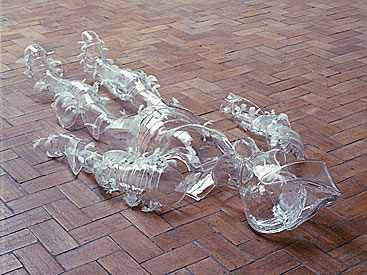
Born in 1963 in Bitche (FR)
Lives and works in Wingen-sur-Moder (FR)

1995-1998
Crystal, feathers
Dimensions variables
Year of Purchase: 1998
‘This dark brightness that falls from the stars’: this is the verse by Corneille usually quoted to students when they need to be reminded that the oxymoron is neither a character who has been killed off twice nor a species of insect, but a traditional rhetorical figure, expressing the tension and intoxication brought on by the paradoxical juxtaposition of two antithetical or incompatible terms. While poetry and literature make only very occasional use of this device (which would lose its effectiveness if overused), there is one art form, at least, that can fairly safely be said to draw its strength almost systematically from a conjunction of opposites, and that is sculpture.
It is the infinite ductility of the folds cut into the toughest marble that captures us in the works of Germain Pilon, the immobilized vivacity that fascinates us in Michelangelo’s Slaves or Rodin’s Balzac. César’s compressions are the very image of two opposite forces, that of the matter which resists and that of the machine which one day forced it to fit into a regular cube. The almost physical commotion induced by the sculptures of the American Richard Serra, is largely due to the fact that steel plates weighing several tons are arranged as they were light Japanese folding screens. Would the Eiffel Tower itself (if I am to be allowed the slight liberty of classifying it as a sculpture) have attained the worldwide fame it now enjoys had it not been a mountain of lace? Patrick Neu plays on the contradictory registers essential to his art with an extremely sure instinct. When he had the idea of casting a 15th century coat of armour out of Saint-Louis crystal, was he perhaps thinking of the famous glass slipper that Perrault placed on Cinderella’s foot? He probably was, and one would likely have no trouble finding the ‘crystal armour’ metaphor in some fairy tale. But in passing from the literary image to a concrete object placed there before our eyes, it is the fragility of the crystal that Patrick Neu makes us feel, as much as the purity or the brightness which are most resonant in the word when it is pronounced. A coat of crystal armour is an object no less absurd, useless and unlikely – but blazing in its impossibility and its uselessness – than Andre Breton’s ‘soluble fish’ or the extravagant machines in the novels of Raymond Roussel. It is a chimera which, instead of combining two animals of different species, as the craftsmen of the cabinets of curiosities used to do, combines a form and a material that are strictly incompatible with one another. This fundamental strange¬ness of the object is further increased by a disorderly scattering of feathers, which covers it as if it had been hastily left behind in a hen house. In the manner of Roussel, Neu seems here to have made an object with words: one will probably never know what story lies hidden behind this crystal armour forgotten in a hen house. Viewers with a taste for mystery will be able to try their hand at unlocking the symbolism of the crystal armour – that is part of the game. But if the work has such a fascination, it is because it gives us to see something that we would rather expect to hear, and combines, in exemplary sculptural fashion, two opposites in a kind of rainbow of forms.(The rainbow is a oxymoron found in nature: in theory, the sun and the rain are not designed to coexist).
Didier Semin